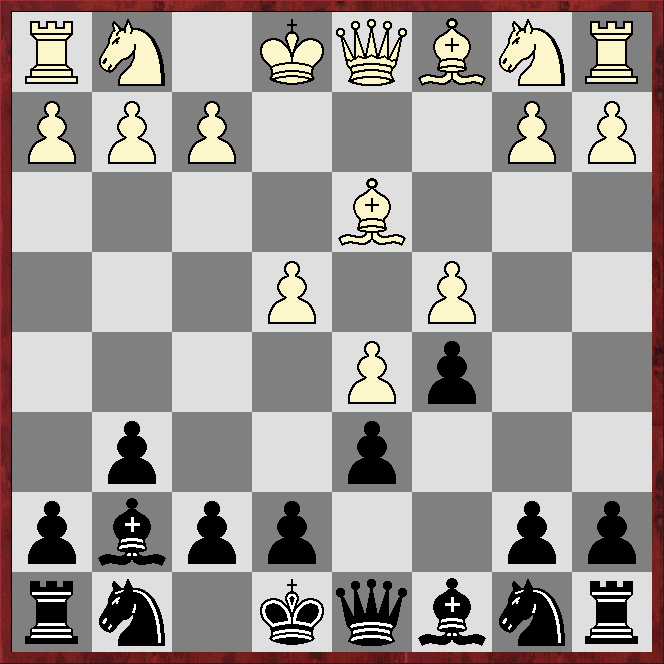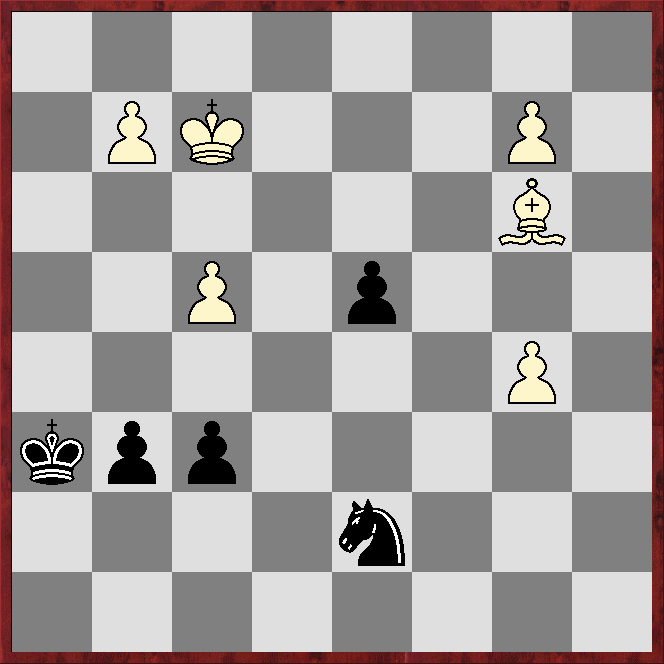Tied with him, and also scoring +5=4-0, was Czech Fide master Daniel Pražák (2314), who gained 33 elo (his K factor is the normal one of 20, meaning he has never reached 2400).
Both players gained an IM norm, and I doubt if either was much bothered that a tiebreak system in an all-play-all tournament favoured one over the other.
They were the top two seeds, and their 11-move draw in round four was not altogether unexpected, especially as the lower-rated of the two had white.
The most impressive part of Papasimakopoulos's performance was perhaps that his two wins against IMs (Pražák 'only' beat one international master) came in successive rounds.
Here is the first of them.
Alexandros Papasimakopoulos (2379) - Angus Dunnington (2259)
Modern Defence
1.d4 g6 2.c4 Bg7 3.e4 c5 4.d5 d6 5.Bd3!?
This continuation is second in popularity in ChessBase's 2025 Mega database, albeit a long way behind 5.Nc3. However, among those who have played it are Akiba Rubinstein, Gersz Salwe, Yasser Seirawan and Anatoly Karpov.
*****
*****
*****
*****
5...e6!?
More common is 5...Nf6, but Stockfish17 and Dragon1 prefer the text, and it scores eight percentage points higher in Mega25.
6.h3!?
Another unusual response, and one that scores just 33% in Mega25, but again a move quite liked by the engines.
6...exd5 7.exd5 Ne7 8.Nf3 0-0 9.0-0
*****
*****
*****
*****
The most significant imbalance is White's extra space in the centre, and the engines reckon that gives White the upper hand.
9...b5!?
This positional pawn sacrifice may be a novelty here, although the idea is well-known in positions in which White has the pawn-formation c4-d5.
*****
*****
*****
*****
10.cxb5
Accepting the pawn is best, according to the engines, while they reckon 10.Re1, their second choice, is at best dubious.
10...a6!?
*****
*****
*****
*****
11.Nc3!?
The engines at first prefer 11.Re1!?, but they come to fluctuate between the two moves, and they agree accepting the second pawn reduces White's advantage.
11...Nd7 12.Re1 Nf6 13.a4 axb5 14.Bxb5 Bb7 15.Bc4 Nf5 16.Bf4 Nd4!? 17.Nxd4 cxd4 18.Nb5 Nxd5 19.Bxd6 Qg5!?
*****
*****
*****
*****
20.Qg4
The engines prefer 20.Qf3, but the text also keeps an advantage.
20...Qxg4 21,hxg4 Rfd8 22.Be5!?
The engines much prefer 22.a5.
22...Nb6
Possibly preferable is first exchanging on e5, and then playing ...Nb6, the engines reckoning 22...Bxe5!? 23.Rxe5 Nb6 24.Bb3 d3 gives counterplay that may leave White only slightly better.
*****
*****
*****
*****
23.Bxg7
The engines point out 23.Bxf7+!? Kxf7 24.Bxg7 Kxg7 25.Re7+. True, after 25...Kg8 26.Rxb7 Black has 26...Rxa4, but White can meet this with 27.Rd1 Nc8 28.Nc3! Nd6 (forced, it seems) 29.Nxa4 Nxb7, reaching a simplified rook-and-knight ending in which White is a pawn up and has what the engines reckon is the upper hand. However it is far from clear the ending is winning, and it may be Papasimakopoulos thought he had better chances in a more complicated middlegame.
23...Kxg7 24.Bb3 Bc6
Pushing the d pawn is more promising, according to the engines.
25.g5?
The engines reckon this throws away all of White's advantage, while they agree 25.Nc7!?, with Re7 to come, gives the upper hand.
25...Bxb5!?
The engines at first much prefer 25...Ra5!? or 25...d3, but Stockfish17 comes to like the text (Dragon1 disagrees).
26.axb5 Rxa1 27.Rxa1 f6?
It seems 27...d3 was necessary, giving equality, according to Stockfish17, although Dragon1 awards White at least a slight edge.
28.f4?!
Much more convincing is directly exploiting Black's error with 28.Ra7+ or 28.Ra6.
28...h6?!
This gives White a second chance to invade the seventh rank with malice, whereas 28...fxg5 29.fxg5 Kf8 keeps the game going, albeit heavily in White's favour.
29.Ra7+ Rd7 30.Rxd7 Nxd7 31.gxh6+ Kxh6 32.Kf2 1-0







No comments:
Post a Comment